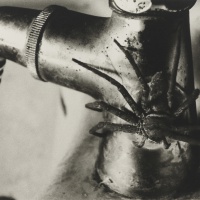Group Show
Daido MORIYAMA, Kou INOSE, Issei SUDA, Akihide TAMURA, Kenji ISHIGURO, Eikoh HOSOE
GALLERY HOURS | Tue.–Sat. 11:00–19:00 (Sat. 13:00–14:00 CLOSED)
CLOSED | Sun-Mon., National Holidays
*Summer Holidays | August 11 – 20
*Depending on COVID-19, the exhibition period and the content may be changed.
Gallery selection: Daido MORIYAMA, Kou INOSE, Masahisa FUKASE, Issei SUDA, Akihide TAMURA, Hiromi TSUCHIDA, Kenji ISHIGURO, Eikoh HOSOE
Artists
Daido MORIYAMA
森山大道
Born 1938 in Osaka. After working as an assistant for photographers Takeji Iwamiya and Eikoh Hosoe, he went independent in 1964. He has been publishing his works in photography magazines among others, and received a New Artist Award from the Japan Photo Critics Association for Japan: A Photo Theater in 1967. Between 1968 and ’70 he was involved in the photo fanzine Provoke, and his style of grainy, high-contrast images that came to be referred to as “are, bure, boke” (grainy, blurry, out-of-focus) made an impact on the realm of photography. Solo shows at New York’s Metropolitan Museum of Art and the Fondation Cartier pour l'Art Contemporain in Paris solidified Moriyama’s worldwide reputation, and in 2012, he became the first Japanese to be awarded in the category of Lifetime Achievement at the 28th Annual Infinity Awards hosted by the International Center of Photography (ICP) in New York. The “William Klein + Daido Moriyama” exhibition together with William Klein at London’s Tate Modern in 2012-13 was a showdown of two immensely popular photographers that took the world by storm.
Kou INOSE
猪瀬 光
Born 1960 in Saitama. Started his career after studying photography under Seiryu Inoue while still enrolled at Osaka University of Arts. While having numerous devoted fans, he doesn’t present new works very often, as his extremely persistent approach is reflected in every single print that he finishes in up to one month of highly concentrated work. Charged with astonishing density and intensity, his works have been awarded a New Photographer Prize at the Higashikawa International Photo Festival in 1993. Photo books include deja-vu #11: Inose Kou (’93) and Inose Kou Visions of Japan (‘98). Solo exhibitions include the “Inose Kou Photo Exhibition” at Space Kobo & Tomo in 2001. He also participated in the group exhibition “Lonely Planet” at Art Tower Mito in 2004, and is presently one of those artists whose exhibitions are most anticipated.
Issei SUDA
須田一政
Born 1940 in Tokyo. Graduated from the Tokyo College of Photography in 1962. Was hired as house photographer for Shuji Terayama’s experimental theater troupe Tenjo Sajiki in ’67, before commencing his work as a freelance photographer in ‘71. A Newcomer's Award from the Photographic Society of Japan for Fushi Kaden catapulted him into the limelight in 1976. He further received the Photographic Society of Japan’s Annual Award for the exhibition of the “Monogusa Syui” series in 1983, followed in ’85 by the 1st Domestic Photography Award at Higashikawa for “Nichijo no danpen”. In 1997, his book Human Memory received several awards including the Domon Ken Prize. In 2013, his large-scale retrospective exhibition “Nagi no hira – fragments of calm” was shown at the Tokyo Metropolitan Museum of Photography. His works capturing moments between reality and non-reality have lately earned a high reputation also outside Japan. Main photo collections include Fushi Kaden (’78), Waga Tokyo 100 (’79), Akai hana – scarlet bloom (2000), Fushi Kaden (definitive edition, 2012), Anonymous Men and Women (’13) and Rei (’15)
Akihide TAMURA
田村彰英
1947 Born in Tokyo, Japan
1969 First solo exhibition, ‘Yume no Hikari (Light of Dream)’ at Ginza Nikon Salon
1974 Included in ’New Japanese Photography’ at Modern Museum of Art, New york with ‘House,' a series of photographs taken in his 20s; resulted in the museum’s purchase
1984 Received New comer Award from the Photographic Society of Japan
Participated as a still photographer for the Japanese film director Akira Kurosawa
His critical awareness always functioned as a main theme, producing works such as 'Base’, ‘House’, ‘Road’, ‘Afternoon' and ‘Wangan’
Kenji ISHIGURO
石黒健治
Born in 1935 in Fukui Prefecture. Graduated from Kuwasawa Design School in 1959, and received a Best New Artist Award from the Photographic Society of Japan in the same year. Main exhibitions include “Fuko na wakamono-tachi,” Natural,” “Theater,” and “Fufu no shozo.” His works have been published in photo books such as Ken-san, HIROSHIMA NOW, and Natural, and in the photo-mystery book Sachiel-shi no passport. His broad-ranged activities further include taking charge of photography for Shohei Imamura’s film A Man Vanishes, and directing the movie “Muryoku no ou” (Toei Central Films) among others.
Eikoh HOSOE
細江英公
Born 1933 in Yamagata. Entered the Tokyo College of Photography (now Tokyo Polytechnic University) in 1952. Developed his own artistic concept while deepening exchange with Ei-Q, leader of the Democratic Artists Association dismissing the existing art system. The solo exhibition ”An American Girl in Tokyo” was held in 1956. In ’59, he established the self-managed photo agency VIVO with the likes of Kikuji Kawada, Shomei Tomatsu and Ikko Narahara, and became a driving force of Japanese photography with his personal creative work. In 1960, he won the Japan Photo Critics Association Newcomer's Award for Man and Woman, and continued to produce a number of outstanding works including his depiction of the aesthetic world of Yukio Mishima in Barakei (Ordeal by Roses), and Kamaitachi, containing photos of Butoh dancer Tatsumi Hijikata shot in rural Akita. In addition to his works as a photographer, Hosoe has been contributing to the popularization and development of photography, and received several awards including the Arts Encouragement Prize from the Ministry of Education, Science and Culture in 1970; the Medal with Purple Ribbon in 1998; and in 2008, the Mainichi Art Award. His most well-known books are Barakei (‘63), Kamaitachi (‘69), Eikoh Hosoe (’86) and Simon: A Private Landscape (’12).






























